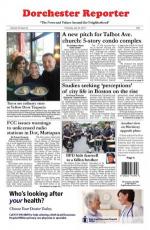January 9, 2008

YouthBuild students Douglas Walker, Kenneth Cardoso and William Brewington, all in their early 20s, move a structural insulated panel into place on the second floor of 26 Arbutus St. Photo by Pete Stidman
Call it another rung on the ladder toward an environmentally sustainable Boston, or perhaps, another tug on the rope that will bring that lofty goal down to earth.
YouthBuild Boston, an organization that has taught values through construction work since their inception in the basement of Roxbury's First Unitarian Church in 1990, is taking the city's advances in green building and pushing them further.
At 26 Arbutus St. in Dorchester they are building one of the Department of Neighborhood Development's prototype two-family designs, but beefing up the particulars to reach LEED Platinum, green-building's most coveted certification.
"Half the cost of the average heating bill, that's our goal: cut the utility bills in half," said Tim Tudor, YouthBuild's general superintendent. "I'll bet it'll be less than half."
The project includes at least two firsts for homes built through the city's DND: Structural Insulated Panels and an insulated concrete form foundation. Both are aimed at sealing the house against Boston's icy winters, making the houses more affordable for their residents in the long-term, not just the purchase price.
"YouthBuild has gone above and beyond our guidelines," said John Feuerbach, DND's senior development officer. "This is like a pioneering effort on their part. They've got the whole area of training and apprenticing down and now they're getting kids involved in a whole new way of building in the city. If they are successful, we could use 26 Arbutus as an example for what we build in the future."
The city agency gave YouthBuild the vacant lot to build on as a tiny part of the larger Franklin Field South Phase III scattered housing development, a result of years of community process.
The city began requiring all the new affordable housing they fund to be LEED Silver certifiable beginning in April 2007, so the ball was already beginning to roll in a green direction. YouthBuild's project could make a higher green target a little easier to reach for those who follow. LEED stands for Leadership in Energy and Environmental Design, a standard created by the Green Building Council based on a point-system. Each environmentally friendly feature gets a certain number of points, and a well sealed and insulated building rates high.
Structural Insulated Panels (SIP) look a lot like giant wafer cookies, with oriented strand board or plywood on the outside and polystyrene or polyurethane foam filling inside. The New England Regional Council of Carpenters built the SIPs being used on the Arbutus Street house made to order. YouthBuild's crew puts the wafer puzzle together when they arrive. When they are interlocked together they create a superior seal and a high level of insulation.
The foundation is made of normal concrete, but instead of building wooden forms to mold the basement floor and walls, blocks of foam are used that fit together like Lego's. Once the foundation is poured, the foam mold is left in place, and sheetrock installed over it for a finished and super-insulated basement.
YouthBuild is grabbing every LEED point they can. The landscaping will include native plants and the rocks they uncovered excavating the foundation, the windows will carry a high U-value and a high efficiency boiler will be installed. Some of the points will come automatically because LEED gives points for Transit Oriented Development and density. Arbutus Street is close to major bus routes, and the new 3,000 square foot two-family will infill a small 5,000 square foot vacant lot in an already dense neighborhood. To make it more green, the house would have to generate it's own electricity.
"John Feuerbach would like us to go for the 0 percent energy usage, so we're going to try maybe next time, but the jury's still out on that," said Tudor. "You can't make the photo-voltaics work out with the subsidies and grants. The payback is just too long."
But Tudor is no pessimist. A shade cynical maybe, but no pessimist. After chuckling about all the promises presidential candidates are making he adds:
"Energy independence in 10 years, that's what Huckabee said. Energy independence in 10 years is what Obama said too. So I guess that means we'll be energy independent in 10 years."



